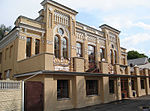Hero City monument, Kyiv

The Hero City monument (officially, the Obelisk in honor of the hero city of Kyiv, Ukrainian: Обеліск на честь міста-героя Києва), is a World War II memorial in Halytska Square in Kyiv, Ukraine. It is a 30 m-tall (98 ft) obelisk that was erected in 1982, during the Ukrainian Soviet Socialist Republic. In its original form it was marked with the dates "1941" and "1945", the starting and ending dates of World War II according to the Soviet Union, and featured a "hero star" reflecting Kyiv's status as a Soviet Hero City. Since the Revolution of Dignity in 2014 the Ukrainian authorities have been decommunizing Ukraine's Soviet-era monuments, in a process which has been accelerated following the 2022 Russian invasion of Ukraine. On 9 February 2023, Kyiv city council renamed the square back from its Soviet-era name of Victory Square to its original name Halytska Square.On 15 September 2023, the Soviet stars were removed from the obelisk, together with the annotation board in the Russian language, and the "1941" marking was changed to "1939" to match the official Ukrainian date for the start of World War II.
Excerpt from the Wikipedia article Hero City monument, Kyiv (License: CC BY-SA 3.0, Authors, Images).Hero City monument, Kyiv
Halytska Square, Kyiv
Geographical coordinates (GPS) Address Nearby Places Show on map
Geographical coordinates (GPS)
| Latitude | Longitude |
|---|---|
| N 50.447 ° | E 30.4916 ° |
Address
Halytska Square
01054 Kyiv
Ukraine
Open on Google Maps










